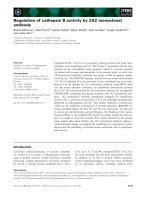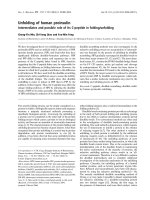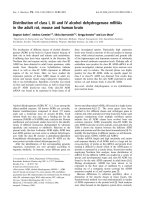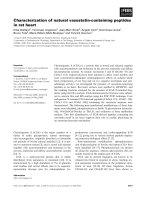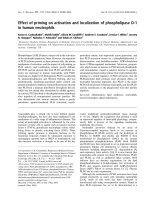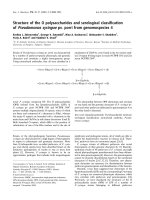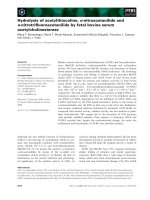Báo cáo khoa học: "Silviculture of high-quality oaks: questions and future research needs" docx
Bạn đang xem bản rút gọn của tài liệu. Xem và tải ngay bản đầy đủ của tài liệu tại đây (225.95 KB, 4 trang )
Original
article
Silviculture
of
high-quality
oaks:
questions
and
future
research
needs
GT
Weaver
H
Spiecker
1
Department
of
Forestry,
Wildlife
and
Fisheries,
The
University
of
Tennessee,
PO
Box
1071,
Knoxville,
TN
37901-1071
USA;
2
Institut
für
Waldwachstum
Bertoldstr
17,
DW-7800
Freiburg,
Germany
(Received
6
January
1993;
accepted
2
June
1993)
Summary —
Oak
forests
are
economically
and
ecologically
important
in
Central
Europe
and
eastern
United
States
of
America.
In
the
former
oak
forests
are
being
returned
by
artificial
regeneration
to
many
sites
where
oaks
had
been
replaced
by
other
species.
Artificial
and
natural
regeneration
meth-
ods
are
being
sought.
Coppice
forests
are
being
replaced
by
forests
of
seed
origin
on
many
sites
throughout
Central
Europe.
Methods
using
wider
spacing
and
shorter
rotations
which
produce
high-
quality
timber
adapted
to
site
quality
are
being
considered.
In
the
USA
reliable
regeneration
remains
a
key
silvicultural
problem.
Effective
means
of
both
artificial
and
natural
regeneration
are
being
sought.
Oak
forest
are
and
will
be
managed
for
a
broader
range
of
objectives
in
Central
Europe
and
the
USA.
Future
research
needs
include
ecophysiology,
growth
and
development,
regeneration,
sil-
vicultural
systems
and
oak
decline.
Quercus
spp
/
silviculture
I
ecology
I
coppice
I
high
forest
/
Central
Europe
I
USA
Résumé —
Sylviculture
des
chênes
de
haute
qualité.
Questions
et
besoins
en
recherches
fu-
tures.
Les
forêts
de
chênes
sont
économiquement
et
écologiquement
importantes
en
Europe
et
dans
l’est
des
États-Unis
d’Amérique.
Dans
le
premier
cas,
les
chênaies
sont
revenues
grâce
à
la
ré-
génération
artificielle
sur
de
nombreux
sites
où
elles
avaient
été
remplacées
par
d’autres
espèces.
Des
méthodes
pour
la
régénération
naturelle
et
artificielle
sont
recherchées.
Les
taillis
sont
rempla-
cés
par
des
futaies
dans
beaucoup
d’endroits
en
Europe.
Les
méthodes
utilisant
de
larges
espace-
ments
et
des
rotations
courtes
qui
produisent
des
bois
de
haute
qualité
adaptés
aux
stations
sont
maintenant prises
en
considération.
Aux
États-Unis,
une
régénération
efficace
reste
une
des
clés
de
la
sylviculture.
Des
moyens
performants
de
mise
en
œuvre
de
la
régénération
artificielle
et
de
la
ré-
génération
naturelle
sont
recherchés.
Les
chênaies
sont
et
seront
aménagées
pour
un
très
large
éventail
d’objectifs
en
Europe
et
aux
États-Unis.
Les
besoins
futurs
en
recherche
incluent
l’écophy-
siologie,
la
croissance
et
le
développement,
la
régénération,
les
traitements
sylvicoles
et
le
dépéris-
sement
du
chêne.
Quercus
spp
/
sylviculture
/
écologie
/
taillis
/
forêt
/
Europe
centrale
/
États-Unis
INTRODUCTION
The
Technical
Session
of
P1
06
"Improve-
ment
and
Silviculture
of
Oaks",
held
during
the
IUFRO
Centennial
Meeting
at
Eber-
swalde/Berlin
in
1992,
has
2
principal
goals:
1)
to
determine
the
status
of
oak
sil-
viculture
in
Central
Europe
and
the United
States;
and
2)
to
identify
research
that
supports
future
management
of
oaks
and
oak
forests.
Conditions,
problems
and
trends
identi-
fied
by
authors
for
various
countries
and
major
research
needs
have
been
summar-
ized
in
this
paper.
On
behalf
of
the
partici-
pants
at
the
sessions
and
those
who
will
benefit
from
the
published
papers,
our
gratitude
and
appreciation
are
expressed
to
the
authors
for
sharing
their
expertise
and
insights
with
us.
PAST
AND
PRESENT
The
papers
in
this
series
stress
the
eco-
nomic
and
ecological
importance
of
oaks
in
the
past
and
present
in
Central
Europe
and
the
United
States.
Their
present
eco-
nomic
importance
is
closely
related
to
the
percentage
of
valued
wood
produced.
Ecological
importance
is
due
to
the
wide
range
of
climatic
provinces
and
sites
pres-
ently
or
formerly
occupied
by
oaks,
and
their
importance
as
components
of
the
wildlife
habitat,
and
in
the
protection
of
soil
and
water
resources.
However,
many
present
oak
forests
are
not
naturally
established
and
do
not
occupy
the
full
range
of
sites
to
which
they
are
adapted.
Conversely,
many
stands
have
been
es-
tablished
and
treated
by
silvicultural
pre-
scriptions
with
little
consideration
for
suita-
bility
taking
into
consideration
differences
in
site
quality.
The
historical
origins
and
past
treatment
of
these
stands
are
often
uncertain
and
increase
the
uncertainty
of
preparing
appropriate
and
effective
pre-
scriptions.
The
history
of
present
stands
affects
their
current
status,
responses
to
treatment
and
potential
for
producing
goods
and
ser-
vices.
These
factors
have
to
be
considered
when
preparing
silvicultural
prescriptions.
Coppice
forests
continue
to
predominate
in
many
regions.
These
forests
often
produce
stems
of
inferior
quality
and
are
generally
regarded
as
less
desirable
than
those
from
seeds
or
planted
seedlings.
A
problem
for
silviculturalists
is
to
determine
how
best
to
convert
these
stands
to
high
forests
(those
originating
from
seed).
Often,
several
age
classes
are
unevenly
distributed
within
management
units,
which
complicates
re-
generation
and
management
for
sustained
yield.
Artificial
regeneration
by
planting
and
di-
rect
seeding
with
a
tendency
towards
wid-
er
spacing
prevails
in
Central
Europe.
Nat-
ural
regeneration
with
various
levels
of
weeding
and
tending
have
been
success-
ful
in
some
regions.
In
the
uplands
of
the
United
States,
natural
regeneration
of
oak
forests
is
much
more
common
but
is
in-
completely
understood
and
is
unreliable
under
many
conditions.
Regeneration
of
oaks
on
high-quality
sites
is
especially
diffi-
cult
and
is
a
primary
constraint
to
intensive
oak
silviculture.
Techniques
for
overcom-
ing
this
problem
are
being
studied
in
sever-
al
countries.
Ecophysiological
factors,
including
drought
resistance,
light
requirement
and
other
environmental
parameters
have
been
studied
for
some
important
species.
Individual
tree
parameters
(crown
dimen-
sion,
stem
diameter)
and
stand
structure
(density,
age
and
species
composition)
have
been
studied
for
several
European
species.
The
relationship
between
growth
and
these
parameters
are
known
for
some
species,
but
effective
practices
for
estab-
lishment,
tending
and
thinning
stands
are
inadequately
known
for
most
species.
Tending
and
thinning
of
stands
in
Central
Europe
have
traditionally
maintained
dense
stands
to
produce
wood
with
rela-
tively
narrow
growth
rings.
Slower
growth
was
believed
to
be
necessary
for
the
de-
sired
wood
quality.
Oak
decline
is
of
major
concern
both
in
Central
Europe
and
east-
ern
United
States.
Although
specific
caus-
es
have
not
been
identified,
research
indi-
cates
physiological
stress
due
to
interacting
factors
(site
conditions,
drought,
insects,
diseases,
tree
age,
genetics).
FUTURE
TRENDS
Interest
in
both
the
economic
and
the
eco-
logical
value
of
oaks
will
continue
and
probably
increase
in
the
future
in
Central
Europe
and
the
United
States.
When
eco-
nomic
return
is
the
goal,
emphasis
will
be
on
high
forests
managed
for
maximum
pro-
ductivity -
either
through
short
rotation
crops
or
on
longer
rotations
for
high
valued
timber.
Past
criteria
for
evaluating
wood
quality,
especially
the
narrow
width
of
growth
rings,
are
being
reevaluated.
Trees
with
larger
diameters,
clear
boles
and
wid-
er
growth
rings
will
be
sought.
In
forests
managed
for
high-quality
wood
products,
either
natural
regeneration
or
seeding
or
planting
at
wider
spacing
will
be
used
to
lower
costs.
Efficient
management
will
be
accomplished
by
several
means,
including
selection
of
a
relatively
small
number
of
crop
trees
and
regulation
of
early
stand
de-
velopment
to
concentrate
site
potential
on
these
trees
to
produce
large
stems
and
de-
sirable
form.
Also
thinning
and
greater
mix-
ture
of
species
in
stands
may
become
more
important,
as
will
site-related
man-
agement
decisions.
The
trend
is
toward
development
of
more
efficient
methods
for
natural
and
arti-
ficial
regeneration
in
Central
Europe
and
the
United
States.
There
is
evidence
that
regeneration
of
some
oak
species
by
plant-
ing
may
be
successful
using
various
shel-
terwood
techniques
in
place
of
the
more
traditionally
used
clearcutting
method.
Ad-
ditional
information
on
the
ecophysiological
responses
of
many
species
to
light
levels,
soil
conditions
and
on
growth
relations
of
competing
species
will
be
needed
to
gen-
eralize
prescriptions
to
other
species
and
regions.
The
genetic
diversity
of
many
oak
forests
is
unknown
due
to
the
uncertain
ori-
gins
of
stands,
seed
sources
and,
in
the
United
States,
to
repeated
high-grading
of
stands.
Assessment
of
genetic
status
of
stands
and
techniques
for
genetic
improve-
ment
of
stands
being
regenerated
are
needed.
Restoration
of
natural
oak
woodland
communities
in
Central
Europe
is
of
in-
creasing
interest.
Species
selection
and
silvicultural
treatments
should
be
adapted
to
sites
and
include
mixtures
of
non-oak
species.
These
forests
will
be
managed
in-
creasingly
as
sustainable
ecosystems
for
a
wider
range
of
products
and
services
than
at
the
present.
Where
economic
return
is
important,
systems
to
produce
valuable
crop
trees
will
be
needed.
Integration
of
management
for
multiple
outputs
will
be
more
important.
Simultaneous
considera-
tion
of
economic
aims,
benefits
to
wildlife,
aesthetics,
recreation
and
soil
and
water
protection
will
increase.
New
silvicultural
systems
will
be
required
as
the
uses
of
oak
forests
diversify.
However,
oak
silviculture
remains
very
intensive
and
often
expen-
sive.
FUTURE
RESEARCH
ACTIVITIES
The
status
of
oak
forests
and
trends
in
their
management
in
Central
Europe
and
the
United
States
as
described
in
this
se-
ries
of
papers
suggest
5
broad
areas
for
additional
research.
These
areas,
with
spe-
cific
recommendations,
follow.
1)
Ecophy-
siology:
determine
the
responses
of
sever-
al
important
species
to
varying
site
and
environmental
conditions,
including
anthro-
pogenic
environmental
changes
and
to
treatments
for
establishing,
tending
and
thinning.
2)
Growth
and
development:
de-
termine
the
relationship
between
growth
of
trees
of
several
species
and
crown
struc-
ture, stand
structure
(stocking
and
species
composition)
and
site
quality.
3)
Regener-
ation:
develop
reliable
natural
regeneration
methods
for
stands
of
mixed
composition
for
a
range
of
sites
and
environmental
con-
ditions.
4)
Silvicultural
systems:
develop
low-cost
systems
for
managing
natural
oak
woodland
communities
for
a
variety
of
goods
and
services.
This
includes:
i)
sys-
tems
for
a
greater
proportion
of
high-
valued
wood
on
shorter
rotations
(<
100
yr);
ii)
systems
for
natural
stands
of
more
diverse
species
compositions
for
a
greater
combination
of
goods
and
services;
iii)
sys-
tems
for
integrated
management
where
multiple
output
is
desired.
5)
Oak
decline:
determine
the
relation
between
oak
decline
and
stand
age
and
structure,
species-site
interactions,
and
pollutants,
insects
and
pathogens
and
their
regulation
by
silvicul-
tural
treatment.

